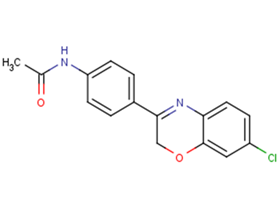
QX77
CAS No. 1798331-92-6
QX77( —— )
Catalog No. M18140 CAS No. 1798331-92-6
QX77 is a chaperone-mediated autophagy (CMA) activator.
Purity : >98% (HPLC)
 COA
COA
 Datasheet
Datasheet
 HNMR
HNMR
 HPLC
HPLC
 MSDS
MSDS
 Handing Instructions
Handing Instructions
| Size | Price / USD | Stock | Quantity |
| 5MG | 65 | In Stock |


|
| 10MG | 110 | In Stock |


|
| 25MG | 200 | In Stock |


|
| 50MG | 332 | In Stock |


|
| 100MG | 494 | In Stock |


|
| 200MG | Get Quote | In Stock |


|
| 500MG | Get Quote | In Stock |


|
| 1G | Get Quote | In Stock |


|
Biological Information
-
Product NameQX77
-
NoteResearch use only, not for human use.
-
Brief DescriptionQX77 is a chaperone-mediated autophagy (CMA) activator.
-
DescriptionQX77 is a chaperone-mediated autophagy (CMA) activator.
-
In VitroQX77 (48 hours) upregulates Rab11 expression levels in Ctns-/-?MEFs.In Ctns-/- MEFs, QX77 recovers the down-regulated LAMP2A expression, and the Rab11-positive carrier vesicles recover the high-motility trafficking phenotype observe in wild-type cells.Treatment with CMA activator QX77 rescues Rab11 down-regulation and trafficking deficiency in cystinotic cells. QX77 treatment also increases LAMP2A localization at the lysosomal membrane.QX77 significantly increases the re-localization of LAMP2A at LAMP1-positive lysosomes in cystinotic cell, it corrects the localization of LAMP2A at the lysosomal membrane in cystinotic cells.QX77 protects cystinotic cells from the increased susceptibility totert-butyl-hydroperoxide-induced oxidative stress and reconstitutes the resistant levels observed in wild-type cells. The effect of QX77 on cystinotic cell survival is dependent on LAMP2A expression.QX77 (10 μM;0, 3 or 6 days) activates CMA and increases LAMP2A expression inD3 and E14 ES cell, it downregulates pluripotency factors and AP reactivity and partially lost the characteristic ES cell morphology.Western Blot Analysis Cell Line:ES D3 cell line; E14TG2a (E14) cell line Concentration:10 μM Incubation Time:3 or 6 days Result:Increased LAMP2A expression and decreased SOX2 and Oct4 protein expression.
-
In Vivo——
-
Synonyms——
-
PathwayAngiogenesis
-
TargetHIF/HIF Prolyl-hydroxylase
-
RecptorOthers
-
Research AreaCancer
-
Indication——
Chemical Information
-
CAS Number1798331-92-6
-
Formula Weight300.74
-
Molecular FormulaC16H13ClN2O2
-
Purity>98% (HPLC)
-
SolubilityDMSO : ≥ 64 mg/mL; 212.81 mM
-
SMILESCC(=O)Nc1ccc(cc1)C2=Nc3ccc(Cl)cc3OC2
-
Chemical Name——
Shipping & Storage Information
-
Storage(-20℃)
-
ShippingWith Ice Pack
-
Stability≥ 2 years
Reference
1.Zhang J, et al. J Biol Chem. 2017 Jun 23;292(25):10328-10346
molnova catalog



related products
-
HIF2α-IN-1
A potent HIF-2α inhibitor with IC50 of <500 nM in HIF-2α scintillation proximity assay.
-
MK-8617
A potent, orally active pan-inhibitor of HIF prolyl hydroxylase (HIF-PHD) with IC50 of 1.0,1.0, and 14 nM for HIF-PHD1, 2, and 3, respectively.
-
Naphthofluorescein
Naphthofluorescein (Naphthafluorescein) is a Mint3 inhibitor with potential antitumor and anti-inflammatory activities, inhibits the interaction between HIF-1 and Mint3, inhibits Mint3-dependent HIF-1 activity, and inhibits glycolytic activity in cancer cells and macrophages without showing significant in vitro cytotoxicity or in vivo side effects.



 Cart
Cart
 sales@molnova.com
sales@molnova.com


